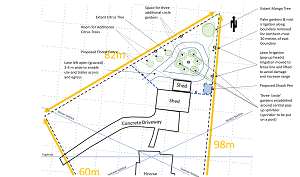One thing I love about any semi-complicated project is the fact that I can do some planning before I get started. The requirement for research, sketches and bouncing ideas around sure creates lots of anticipation, and the anticipation really is half the fun!
So at the moment one particular project that I'm turning over in my head (whilst I'm out of the country and not able to turn soil) is a fruit and vegetable garden for the back yard of my new house that makes use of permaculture principals. What's permaculture? I hear you think! There's a party line that the purists use, and I can't remember, so I'll summarise: smart + lazy + environmentally sustainable = permaculture.
In this post I'll take you through my plan for my fruit and vegetable garden, explaining the principals and elements of permaculture that I plan to employ to make it as productive as possible, with the least possible effort. At the end I'll give links to the online resources that I've used (starting with a proper explanation of what permaculture is and it's design principles).
The Canvas
I started by making the most accurate areal sketch of my back yard that I could. Google earth was handy for this, particularly since I could measure distance with it! To this sketch map I added existing gardens, trees, fences and irrigation as well as the angles that the sun will be at for the summer and winter solstices (see resources at the bottom for sun angle calculator). This may sound tedious, but like I said; the anticipation is half the fun. In fact I consider myself lucky to be away form the property so that I'm forced to think about it so deliberately. Otherwise my enthusiasm might get the better of me and I'd race out back and establish a garden without the necessary forethought to ensure its success. No doubt a lot of garden's start this way; and suffer for it.
Figures 1 & 2, below, show the start point and desired end state for my back-yard, have a look, then I'll explain a little more.
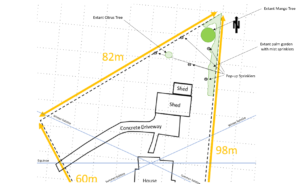
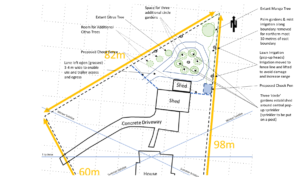
To elaborate on a few features of the plan shown in Figure 2:
- The main component of the garden; the circle of circle-gardens (I'll explain what they are soon) is located where it will get sufficient sunshine all year round and not be shaded out by nearby trees or structures.
- The circular track around the garden has more to do with the principals of logistics than permaculture. Firstly; it means that there is no need to ever reverse a vehicle and/or trailer in the garden, as this can result in churned up ground and knocked over or squashed plants, Secondly; the track limits the distance that anything needs to be carried in or our of the garden. For example if I were to take bulk bananas or pumpkins out, I would never have to walk/carry more than 10 paces from the trailer or ute, and Finally; the track gives a clear space to allow sunlight onto the circle of circle gardens during the morning and afternoon.
- Everything you see on this plan for my backyard, fits a classic permaculture 'Zone 2' definition. Zone 2 means it can be irrigated, if the climate demands it, yet it can otherwise go for up to a week without any real attention from me. This garden will include a number of rambling plants like pumpkin and sweet potato that are not going to 'stay inside the lines' so to speak, as a result this garden is probably going to look messy, but my goal is for it to feed the family, not look pretty. (if my mention of 'Zones' has piqued you curiosity, they're covered in the link at the bottom)
- The location of the chook pen on the boundary speaks to the fact that there are times when I may want the chooks to have free reign in the back garden and times when I will give them their daily outing in the front yard, so as to keep them away from delicate seedlings or shoots.
The Circle Gardens
As you've seen in figure 2, circle gardens are central to my plan, and as such they warrants their own detailed explanation.
The circle garden, most commonly referred to as a Banana Circle (because nine times out of ten they feature banana trees) and very occasionally referred to as a pit garden, has multiple functions, but before I explain them further take a look at the below cross-section sketches to get a mental picture.
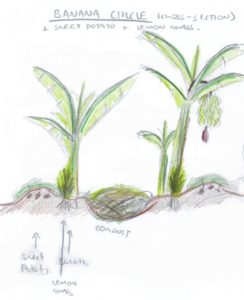
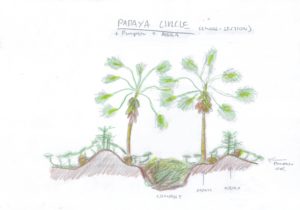
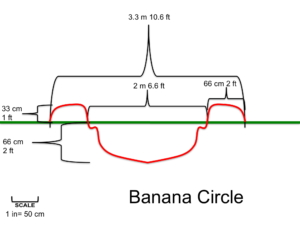
A circle garden is established by digging a hole and throwing the soil in a circle (or doughnut) around that hole in accordance with the dimensions in figure 5. If you have existing grass or weeds on the ground that you don't want to grow through your circular pile of dirt/doughnut you can lay down newspaper or weed matting of some sort before you start digging/mounding. From here, in simple terms; compost, plant plants that will complement each other and add water and reap the bountiful harvest!
In more complex terms; the bountiful harvest you can reap from a circle garden has to do with a number of mutually beneficial relationships that are going on therein. Here they are in no particular order:
- The hole in the middle serves as a water catchment, which feeds the roots of the surrounding pants. This can be enhanced by piping grey-water in or channeling runoff into the hole. There is a bit a test and adjust required here as each garden's water input will be dependent upon water/rainfall available, and what the plants in the circle garden need. The classic Banana circle, with some taro toward the inside, for example, will be pretty hard to over-water. Conversely; plants that like to keep their feet dry, like sweet potato or passion fruit, will warrant less watering or they can be grown higher up on the doughnut mound, or further to the outside of the circle in order to limit the water they get. An interesting side note is that in a semi-permanent bush camp setup; planting a banana circle with water loving plants around an outdoor shower provides a means to absorb water, provide shade and privacy and, of course, fruit and veg.
- The hole in the middle of the circle garden also accommodates a compost heap. As organic matter in this heap decomposes it feeds the plants around it. Best of all, because the compost heap is right next to the plants, it alleviates the need to carry waste across your yard: When you cut down a banana tree/plant after it's yielded its bunch, throw/collapse it into the middle; when you pull out superfluous banana suckers, throw them into the middle; when you pull out weeds, throw them into the middle; when Papaya/Pawpaw trees shed their leaves, throw them into the middle; and so on. By comparison, in a traditional garden setup you'd have to haul organic waste across the yard to a compost heap, and then haul it back again when it's composted, or worse still you could burn it or take it to the tip. The reduction in manual labour relative to fruit/vegetable output is, in my opinion, the greatest benefit of a circle garden. There are a few tricks required for a successful compost heap: It should be started with a pile of logs or large branches in the bottom, these will help aerate it and give it a starter of fungi that will assist decomposition; The compost heap also needs to get to the right temperature for decomposition, this can be assisted by throwing a tarpaulin over the top of it to get it going in the early days; and finally the top of compost heap should be kept in a convex shape so that excess water runs to the sides, where the plants in the circle garden can use it. If the compost heap is not convex on top, too much water will seep through its center, cooling it down and slowing/stopping its decomposition.
- Excepting the fact that I've already got irrigation setup in my back-yard; If you need to water a circle garden and you don't have pre-existing irrigation, this can be done with a standard, inexpensive sprinkler-head that puts out water in a circular pattern. Put said sprinkler on the end of a garden hose and thrown into the middle of the circle (on top of the compost heap) that's all, it will reach everything in the garden at once! By comparison, when fruit and vegetables are planted in rows, the layout often necessitates either a dedicated irrigation system, or a human with a hose in hand spending considerable time on task to achieve appropriate water coverage.
- Whilst the circle garden tends to be named after the biggest plant/tree therein, eg: banana circle, papaya circle or coconut circle. The circle is not intended to support just one plant. In fact a mono-culture is the exact opposite of what we're trying to achieve, because having a diverse range of plants that benefit each other in a number of ways (which I'll give examples of below) enables the high productivity form a relatively small area. Some examples of how different plants help each other are:
- Ground covers like pumpkin and sweet potato grow quickly and crowd out weeds, which would otherwise sprout quickly in disturbed soil, thereby reducing competition for the other plants that you want to grow. Additionally the low shade that these ground covers provide helps to stabilise soil temperatures, which is conducive to plant growth.
- Lemongrass, citronella and marigolds can provide a windbreak, their scents deter/confuse pests and they can easily be chopped and dropped, to go either into the center compost heap or to be left on the doughnut mound as mulch.
- Pineapples can be planted as a physical barrier or spiky obstacle to deter dogs, wallabies and other fauna from interfering with other plants.
- And finally larger plants/tress like pawpaw/papaya, banana, corn and coconut are slightly more deeply rooted, thereby not competing with the above mentioned plants; meanwhile they provide a trellis for climbing plants like beans and passion fruit. Perhaps most importantly; large trees and plants provide shade at a higher level, and cool the moist tropical breeze, which is of greatest benefit to the humans overseeing and profiting from this small eco-system.
Finally the Chooks
The final part of the plan, the one which I ultimately have the least control over, are the chickens. They are first and foremost excellent pest controllers, and will turn protein in the form of insects into protein that I can eat.
They are great at turning over soil and fertilising it, however; what I will have to wait and see is what level of damage, if any, they do to the doughnut mounds that I build, or if they get into the habit of destroying my compost piles.
None of these are problems that can't be solved with chicken wire, but I hope it doesn't come to that as that's effort that I want to avoid putting in. we'll wait and see.
Farewell for now.
That's all of my thoughts on this new garden, if you have any comments or suggestions please add them in as I'm a learner on this journey too. I'll be sure to post on the progress of this garden as it takes shape, however the way things are going (thanks to COVID-19) when I get posted back to Australia and am able to move into my house remains unknown!

Resources:
What is Permaculture - Here's the long version that I can never remember. https://www.permaculture.co.uk/what-is-permaculture
Permaculture Design Principles and Guidelines - There is plenty online about permaculture principles, but this link gives a good entry level explanation. It's a 30 minute read which will give you a few pleasant 'ah-ha!' moments. https://www.tropicalpermaculture.com/permaculture-design.html
Permaculture Zones - These are covered in the above link too, but to save you having to find them. https://www.tropicalpermaculture.com/permaculture-zones.html
Sun Angle Calculator. This online tool that will give you the angles that the sun will transit the sky at any given place on earth, on any given day of the year: https://www.suncalc.org/#/-19.2571,146.8214,9/2020.04.12/22:16/1/3 . This particular URL will take you to Townsville specifically, but at can easily be adjusted for any location. There are a few other websites that fulfill the same function that you may want to try, just search for "Sun angle calculator" and you'll find them.
